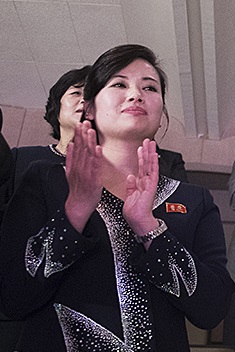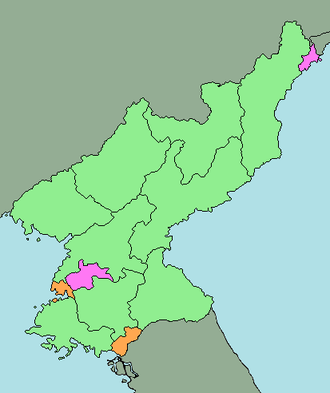Telecommunications in North Korea refers to the communication services available in North Korea. North Korea has not fully adopted mainstream Internet technology due to its isolationist policies.

Pyongyang is the capital and largest city of North Korea, where it is sometimes labeled as the "Capital of the Revolution". Pyongyang is located on the Taedong River about 109 km (68 mi) upstream from its mouth on the Yellow Sea. According to the 2008 population census, it has a population of 3,255,288. Pyongyang is a directly administered city with a status equal to that of the North Korean provinces.

The Chosun Ilbo is a daily newspaper in South Korea and the oldest active daily newspaper in the country. With a daily circulation of more than 1,800,000, the Chosun Ilbo has been audited annually since the Audit Bureau of Circulations was established in 1993. Chosun Ilbo and its subsidiary company, Digital Chosun, operates the Chosun.com news website, which also publishes web versions of the newspaper in English, Chinese, and Japanese. The paper is considered a newspaper of record for South Korea.

North Hwanghae Province is a province of North Korea. The province was formed in 1954 when the former Hwanghae Province was split into North and South Hwanghae. The provincial capital is Sariwon. The province is bordered by Pyongyang and South Pyongan to the north, Kangwon to the east, Kaesong Industrial Region and South Korea's Gyeonggi Province to the south, and South Hwanghae southwest. In 2003, Kaesong Directly Governed City became part of North Hwanghae as Kaepung County. Later on in 2019, it was promoted as Special City. Thus, it was separated from North Hwanghae.

South Pyongan Province is a province of North Korea. The province was formed in 1896 from the southern half of the former Pyongan Province, remained a province of Korea until 1945, then became a province of North Korea. Its capital is Pyongsong.

Ryanggang Province is a province in North Korea. The province is bordered by China (Jilin) to the north, North Hamgyong to the east, South Hamgyong to the south, and Chagang to the west. Ryanggang was formed in 1954, when it was separated from South Hamgyŏng. The provincial capital is Hyesan. In South Korean usage, "Ryanggang" is spelled and pronounced as "Yanggang" Korean: 양강도; RR: Yanggang-do, Korean pronunciation:[jaŋ.ɡaŋ.do]).

Chŏngjin is the capital of North Korea's North Hamgyong Province (함경북도) and the country's third-largest city. It is sometimes called The City of Iron.

Chagang Province is a province in North Korea; it is bordered by China's Jilin and Liaoning provinces to the north, Ryanggang and South Hamgyong to the east, South Pyongan to the south, and North Pyongan to the west. Chagang was formed in 1949, after being demarcated from North Pyongan. The provincial capital is Kanggye. Before 2019, Chagang was the only province of North Korea completely inaccessible to tourists, possibly due to weapons factories and nuclear weapon facilities located there. In 2019 the city of Manpo became accessible to tourists. In May 2018, the province became a "Special Songun Revolutionary Zone" in relations to concealing the nuclear weapon and weapon's factories within the province.

The administrative divisions of North Korea are organized into three hierarchical levels. These divisions were created in 2002. Many of the units have equivalents in the system of South Korea. At the highest level are nine provinces and four special municipalities. The second-level divisions are cities, counties, and districts. These are further subdivided into third-level entities: towns, dongs (neighborhoods), ris (villages), and workers' districts.

Kang Chol-hwan is a North Korean defector, author, and the founder and president of the North Korea Strategy Center.

Kim Ok is a former North Korean government employee who served as Kim Jong Il's personal secretary from the 1980s until his death. After the death of Ko Yong-hui in August 2004, she regularly met with foreign officials as de facto first lady, and was rumored to be the supreme leader's fourth wife.
A dong (Korean: 동) or neighborhood is a submunicipal level administrative unit of a city and of those cities which are not divided into wards throughout Korea. The unit is often translated as neighborhood and has been used in both administrative divisions of North Korea and South Korea.

Okryu-gwan or Okryu Restaurant is a restaurant in Pyongyang, North Korea, founded in 1960. South Korea analyst Andrei Lankov describes it as one of two restaurants, the other being Ch'ongryugwan, which have "defined the culinary life of Pyongyang" since the 1980s, and a "living museum of culinary art".
Kim Kyong-hui is the aunt of current North Korean leader, Kim Jong Un. She is the daughter of the founding North Korean leader Kim Il Sung and the sister of the late leader Kim Jong Il. She currently serves as Secretary for Organization of the Workers' Party of Korea. An important member of Kim Jong Il's inner circle of trusted friends and advisors, she was director of the WPK Light Industry Department from 1988 to 2012. She was married to Jang Song-thaek, who was executed in December 2013 in Pyongyang, after being charged with treason and corruption.

Vice Marshal Ri Yong-ho was a North Korean military officer who was Chief of the General Staff of the Korean People's Army from 2009 to 2012, as well as a member of the Presidium of the Workers' Party of Korea from September 2010 to July 2012.
The Kyungsung FC–Pyongyang FC rivalry, commonly known as the Kyung-Pyong Football Series, was a football rivalry in the early 20th century between Seoul and Pyongyang which are currently capital of South Korea and North Korea. The clash between Korea's two biggest cities was considered as the biggest rivalry in Korea. Seoul and Pyongyang developed historical rivalry for over a century, and their football teams were no exception.

Hyon Song-wol is a North Korean singer, band leader, and politician. She is the leader of the Moranbong Band and of the Samjiyon Orchestra. She was formerly a featured vocalist for the Pochonbo Electronic Ensemble in the early 2000s, a pop group which found fame in North Korea in the late 1980s and 1990s. She has been a member in the Central Committee of the Workers' Party of Korea since 2017.
Kim Hyok-chol is a North Korean diplomat. Kim is the first ambassador in Spain, however, he was expelled in 2017.













